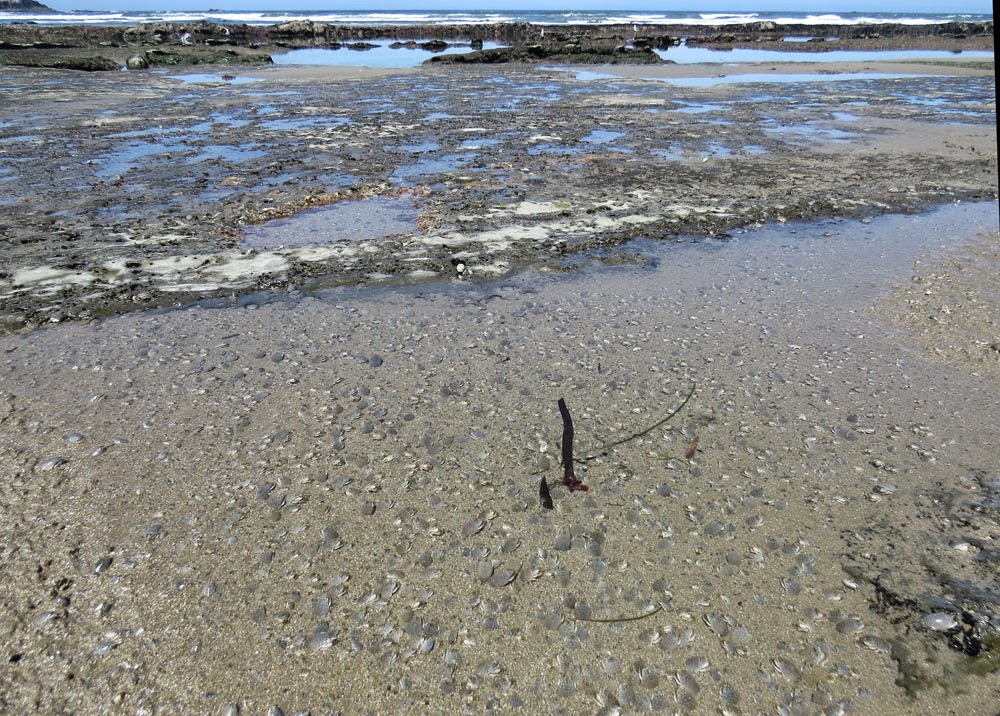One of the
breaks from my working, cooking, and knitting routing while in Oregon earlier
this month was visiting my friends Eve and Rob Gill in Toledo, Oregon, where I
joined them for just a couple days in their wholesome routines of retirement,
including eating healthy, fresh foods, qigong exercises, and walks on the
beach.
Their
current favorite is Schooner Beach, a southern extension of Moolack Beach north
of Newport, immediately north of Yaquina Head.
On our first
afternoon, it was high tide, and there wasn’t much invertebrate life to be
noticed. But we did walk most of the way to Starfish Cove and spotted this
immature Bald Eagle, a bird that Rob and Eve have come to know well.
We also saw
these two Heermann’s Gulls and at least three Black Oystercatchers at the creek
mouth.
Walking back
close to the bluffs, looking for interesting fossils and stuff, I noticed this
blooming Trailing Pearlwort (Sagina
decumbens ssp. occidentalis), an
inconspicuous member of the carnation family.
We returned
the next morning at low tide, one of the lowest of the month, and what a
difference.
The southern
base of Yaquina Head is famous for its tidepooling, but there was a lot to see
here on these isolated rocks on the beach. We probably saw five or six species
of fish, including these Tidepool Sculpins (Oligocottus
maculosus), the only ones that photographed halfway decent through the
water surface.
The Ochre
Sea Star (Pisaster ochraceus) is
normally a very common animal here, and this apparently healthy one was on an
isolated rock near the low tide line.
But in the
deeper crevices and pools I found only two others, and they were both showing
signs of the now year-old plague called the sea star wasting syndrome, the
devastating the populations up and down the coast. Nicknamed the “Pisaster
Disaster,” the cause is apparently still unknown, though a pathogen is
suspected. There is lots of information and press released to be found on the
web, but the central clearinghouse for information is this
website run by the University of Santa Cruz.
While
several species of sea stars are afflicted, other organisms are fine, such as
this pretty, pink-tipped Aggregating Anemone (Anthopleura elegantissima).
The yellow
plumes identify this sea slug (nudibranch) as the Monterey Sea Lemon (Archidoris montereyensis).
This is
Purple Ribbon Worm (Paranemertes
peregrina) is a vicious predator of other worms.
It was fun
to discover this very concentrated aggregation of Pacific Mole Crabs (Emerita analoga). Apparently they
colonize Oregon beaches as larvae from California, with no self-sustaining
populations this far north. That may be changing.
I’m not sure
whether this tiny crustacean, apparently scavenging on a remnant of a
jellyfish, is an amphipod or isopod; it’s not like any of the species in
Bugguide.
This Black
Oystercatcher was one of a pair on the rocks near Starfish Cove, whistling
excitedly at the other beachcombers and tidepoolers; I suspect they had a nest
nearby.
On the way
back, we picked along the wrack line, finding some nice clam fossils and living
invertebrates. This click beetle is in the genus Athous.
I had no
idea what family this odd looking, tiny (3 mm) beetle belonged to, but thanks
to Vassily Belov on Bugguide, I found that it’s merely a carabid (ground
beetle), Akephorus obesus. Given that
it’s apparently restricted to beaches in the Pacific NW, I declare its English
name the Obese Beach Beetle.
This much
larger beetle is in the same family, but a different subfamily, and is the Greater
Night-stalking Tiger Beetle (Omus
dejeanii). It’s largely nocturnal and is unusual in being a flightless
tiger beetle.


























No comments:
Post a Comment